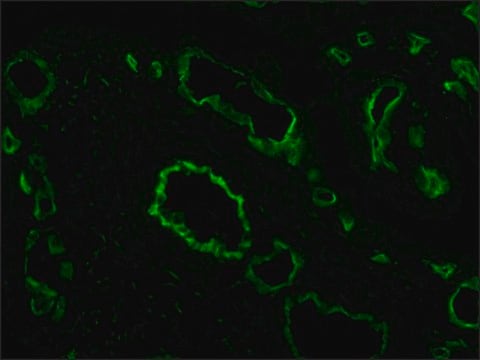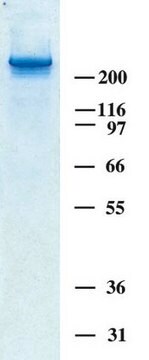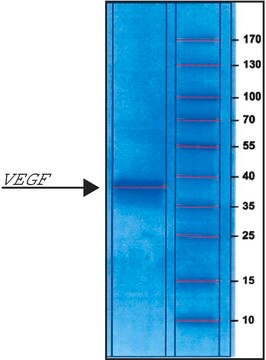ECM002
Thrombospondin-1 human
recombinant, expressed in HEK 293 cells, lyophilized powder, suitable for cell culture
Synonym(e):
THBS, THBS1, TSP, TSP1, Thrombospondin-1
About This Item
Empfohlene Produkte
Biologische Quelle
human
Qualitätsniveau
Rekombinant
expressed in HEK 293 cells
Sterilität
sterile
Assay
≥95% (SDS-PAGE)
Form
lyophilized powder
Mol-Gew.
127.5 kDa (The protein migrates as a 140 kDa band on SDS-PAGE due to glycosylation.)
Verpackung
pkg of 50 μg
Methode(n)
cell culture | mammalian: suitable
Verunreinigungen
≤1 EU/μg endotoxin, tested
Löslichkeit
water: soluble
NCBI-Hinterlegungsnummer
UniProt-Hinterlegungsnummer
Versandbedingung
dry ice
Lagertemp.
−20°C
Angaben zum Gen
human ... THBS1(7057)
Allgemeine Beschreibung
Anwendung
- To treat hepatocyte (IHH) cancer cells to study the role of aspartyl protease 1 (MfSAP1) in extracellular matrix degradation.
- In in vitro Extracellular Matrix (ECM) protein degradation assays.
- In rat C6 astroglioma cells, for coating the cell culture plates to study the effects of integrins on CNTF (ciliary neurotrophic factor) expression.
- In the preparation of secreted factor cocktail for analysis of the human mesenchymal stem cell secretome.
Recommended for use as a cell culture substratum at 1-5 μg/cm2 or 0.1-25 μg/ml. Optimal concentration depends on cell type as well as the application or research objectives.
Biochem./physiol. Wirkung
Leistungsmerkmale und Vorteile
- Human-derived thrombospondin
- Produced through recombinant expression in HEK 293 cells
- Low endotoxin levels
Physikalische Form
Hinweis zur Analyse
Lagerklassenschlüssel
11 - Combustible Solids
WGK
WGK 2
Flammpunkt (°F)
Not applicable
Flammpunkt (°C)
Not applicable
Hier finden Sie alle aktuellen Versionen:
Analysenzertifikate (COA)
Die passende Version wird nicht angezeigt?
Wenn Sie eine bestimmte Version benötigen, können Sie anhand der Lot- oder Chargennummer nach einem spezifischen Zertifikat suchen.
Besitzen Sie dieses Produkt bereits?
In der Dokumentenbibliothek finden Sie die Dokumentation zu den Produkten, die Sie kürzlich erworben haben.
Artikel
Attachment Factors for 3-Dimensional Cell Culture
The extracellular matrix (ECM) is secreted by cells and surrounds them in tissues.
Unser Team von Wissenschaftlern verfügt über Erfahrung in allen Forschungsbereichen einschließlich Life Science, Materialwissenschaften, chemischer Synthese, Chromatographie, Analytik und vielen mehr..
Setzen Sie sich mit dem technischen Dienst in Verbindung.







